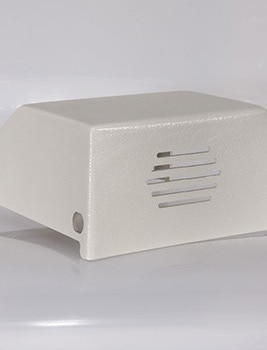Polycarbonates are a group of thermoplastic polymers that are easily moldable, have high impact and temperature resistance, and are highly transparent to visible light. Thermoforming polycarbonate has numerous applications and can be used by many industries, including automotive, aerospace and aviation, building and construction, and medical equipment.
Thermoforming Polycarbonate 
Thermoforming polycarbonate is a manufacturing process that involves heating plastic sheets of polycarbonate to a soft, pliable state, then fitting them around a mold to form the desired shape. The shaped plastic then gets cooled down and trimmed to create a usable product. Ideal temperatures for thermoforming polycarbonate are between about 300 and 500°F. Polycarbonate becomes more flexible the higher the temperature, but if you heat it long enough or exceed the limit of its operational temperature range (215°F – 450°F), it becomes difficult to use.
Thermoforming Polycarbonate Process
Pre-Drying Polycarbonate: This preliminary step removes any trapped moisture before the thermoforming process and prevents the formation of moisture blisters. However, be careful not to overheat the sheet as heating too fast will cause heat to accumulate at the sheet surface,
degrading it.
Heating Polycarbonate: The second step is to heat pre-dried polycarbonate material to a temperature between 350°F–375°F. This step makes it possible to shape the sheets into complex forms with tight curvatures and also allows for deep drawing techniques.
Shape Polycarbonate: As soon as the heaters are withdrawn, the polycarbonate sheet can be pre-blown to the necessary height, and a vacuum is applied to ensure that the sheet firmly forms over the mold.
Cool Polycarbonate: This is the final step in the thermoforming polycarbonate machining process. You can now lift the polycarbonate sheet off the mold at a temperature of about 194°F and cool it with compressed air.
Three Thermoforming Methods
There are three common thermoforming methods:
Vacuum Forming: This is the most basic thermoforming method, where a sheet of polycarbonate plastic is heated until pliable, then placed over a mold. A high-powered vacuum is fitted between the heated plastic and the mold and is then used to suction out the excess air, pulling the plastic into the mold surface to create the desired shape. Vacuum forming isn’t ideal for plastics that require sharp edges or high levels of detail.
Pressure Forming: This method is suitable for large pieces of plastic that require sharp edges and intricate details. It’s also an affordable alternative to injection molding. With pressure forming, manufacturers heat sheets of polycarbonate to pliability, then highly pressurized air is applied against the plastic, pressing it against the mold to create the final form.
Twin-Sheet Forming: This is the most complex method of polycarbonate machining, requiring high levels of accuracy and attention to detail. Two sheets of plastic are heated and shaped at the same time, then lined up and fused. There’s no allowance for error during the fusion of both sheets, and they must be precisely aligned to join together properly. Twin-sheet forming is ideal for constructing hollow and double-walled industrial products such as vending machines, bed liners, air ducts, and pallets. However, COMCO Plastics does not offer this thermoforming method.
Thermoforming Polycarbonate at COMCO Plastics
Thermoforming polycarbonate is widely used across many industries. However, to achieve usable products, you need to thermoform the plastic at exact temperature thresholds. At COMCO Plastics, we offer high-quality, competitively priced, thermoforming polycarbonate services. Contact us today to request a free quote and learn more about our thermoforming services and how they can benefit your company.

